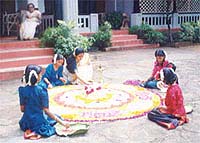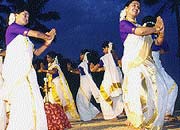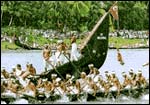 |
 |
|
 |
 |
ONAM
 Onam
is the harvest festival of Kerala which brings along with it, a wide
spectrum of colours, tasty sumptuous dishes, vibrant dances, music and a
soothing, verdant and green atmosphere.
Onam
is the harvest festival of Kerala which brings along with it, a wide
spectrum of colours, tasty sumptuous dishes, vibrant dances, music and a
soothing, verdant and green atmosphere.
According to legend, the state's most colourful festival, Onam, celebrates the golden age of King Mahabali, the mythical ruler of Kerala. The festival is to welcome the spirit of King Mahabali, and to assure him that his people are happy and wish him well. The myth goes like this :
The
Devas or Gods were worried over the wise and good rule of Mahabali, the
Asura king, thinking that he might become too powerful.  They sought the
help of Vishnu (the Preserver in the Hindu trinity) to curb Mahabali's
power. Vishnu, in the form of a dwarf called Vamana, approached him and
was offered a boon by the king. The Vamana asked for three paces of land
and the king agreed to it. Soon the dwarf began to expand and with the
first step, he covered the sky, blotting out the stars, and with the
second, he straddled the netherworld. Realising that Vamana's third step
will destroy the earth, Mahabali offered his head as the last step. The
Gods were glad, but since Mahabali was so attached to his kingdom and the
subjects and was very much loved by the people, he was allowed to return
once a year.
They sought the
help of Vishnu (the Preserver in the Hindu trinity) to curb Mahabali's
power. Vishnu, in the form of a dwarf called Vamana, approached him and
was offered a boon by the king. The Vamana asked for three paces of land
and the king agreed to it. Soon the dwarf began to expand and with the
first step, he covered the sky, blotting out the stars, and with the
second, he straddled the netherworld. Realising that Vamana's third step
will destroy the earth, Mahabali offered his head as the last step. The
Gods were glad, but since Mahabali was so attached to his kingdom and the
subjects and was very much loved by the people, he was allowed to return
once a year.
Onam (Thiruonam) is considered to be the day when King Mahabali comes from exile to visit his beloved people.
This festivities begin ten days before Thiruonam. A magnificent procession of elephants enthrall you at Trichur (Thrissur). Every festival's end is marked by the bursting of firecrackers. The Kathakali dancers adorned in their colourful garb and bright make-up entertain the crowds at Cheruthuruthy. They depict stories from the epics, Pulikali, also known as Kaduvakali which is a common sight during the Onam season. Performers painted like tigers in bright yellow, red and black, dance to the beats of instruments like udukku and thakil.
 The
Vallamkali (boat race) is one of the main attractions of Onam, and is best
seen at Aranmulai and Kottayam. About a hundred oarsmen row huge and
graceful odee (boats). Oars dip and flash to the rhythm of drums and
cymbals in each boat. The songs are generally typical in character and
concern people well known in Malabar. Above each boat silk umbrellas are
perched : their number denotes the affluence of the family owning the
boat. Gold coins and tussles hang from the umbrellas.
The
Vallamkali (boat race) is one of the main attractions of Onam, and is best
seen at Aranmulai and Kottayam. About a hundred oarsmen row huge and
graceful odee (boats). Oars dip and flash to the rhythm of drums and
cymbals in each boat. The songs are generally typical in character and
concern people well known in Malabar. Above each boat silk umbrellas are
perched : their number denotes the affluence of the family owning the
boat. Gold coins and tussles hang from the umbrellas.
In the evening girls perform the Kaikottikkali (Thiruvathirakkali ) in the open, dancing around the traditional brass lamp.